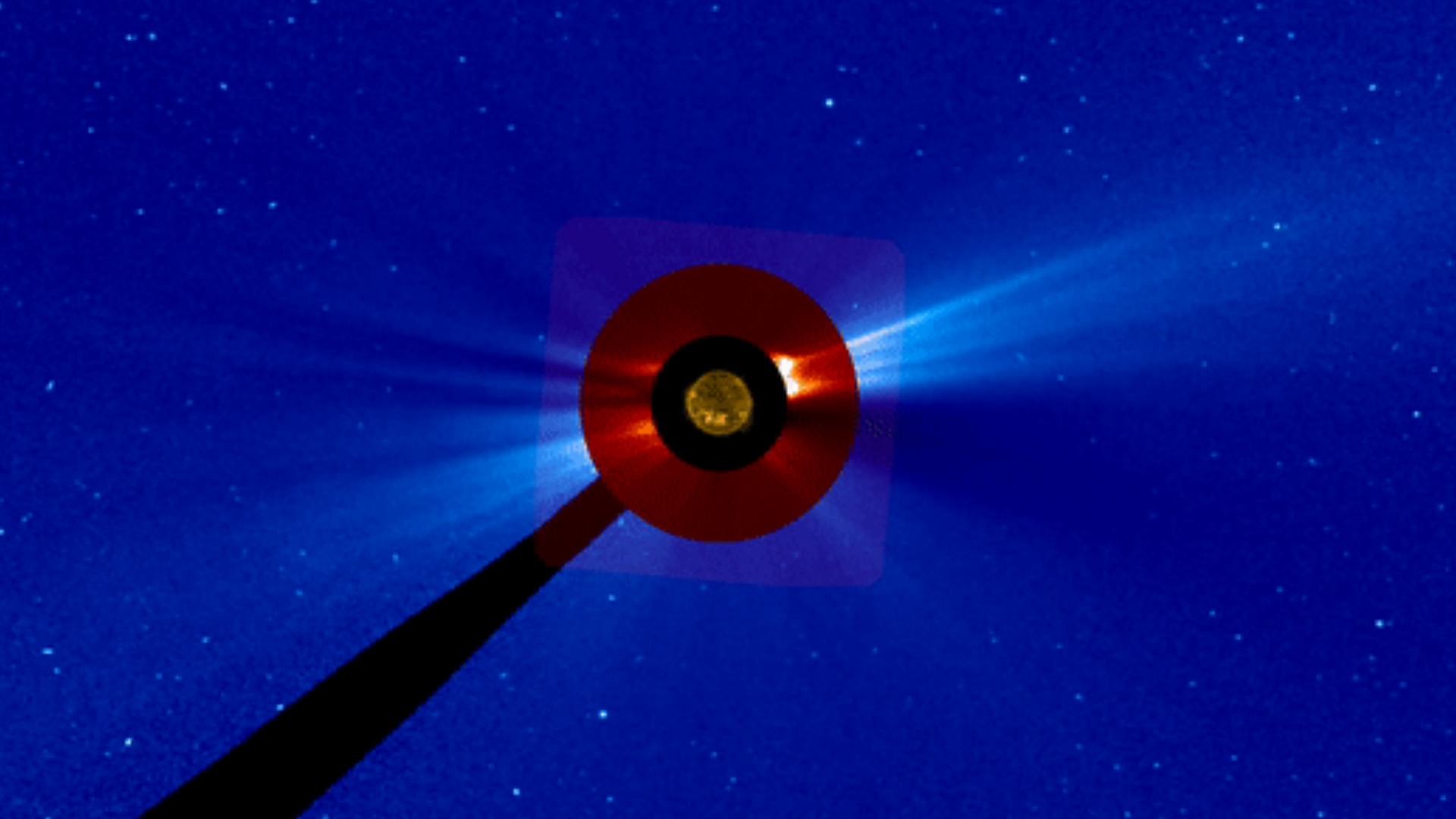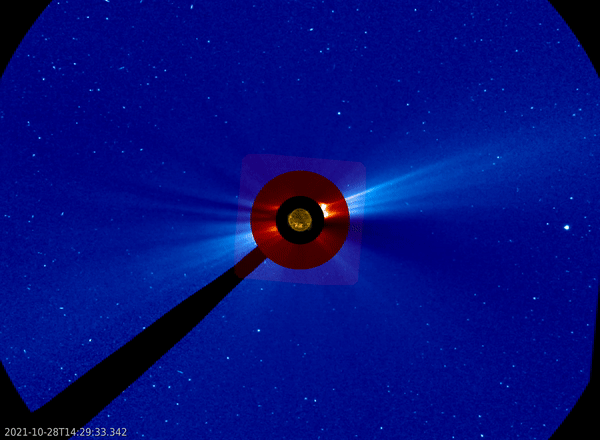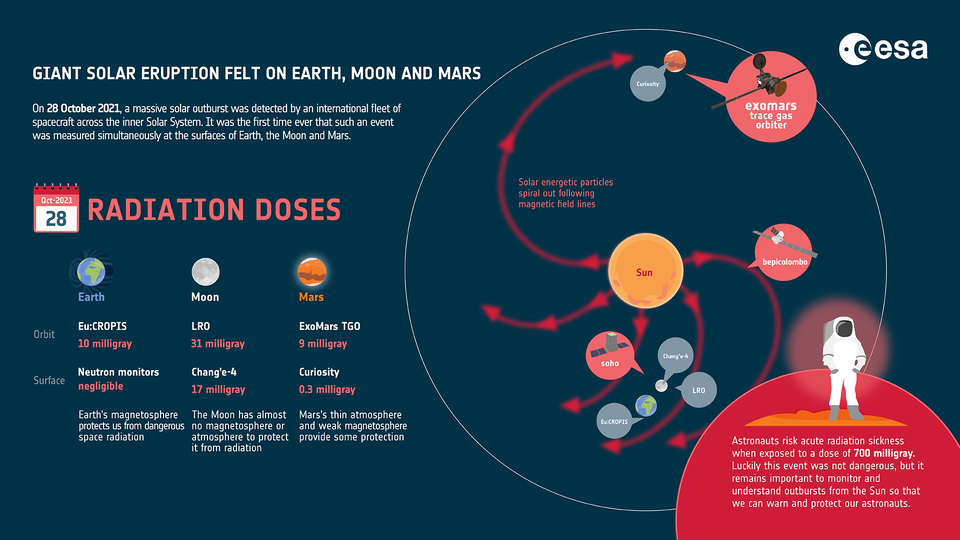
A solar eruption that occurred in Oct. 2021 was simultaneously detected here on Earth, on the moon — and even on Mars.
By detecting the same coronal mass ejection (CME) on these three different worlds for the first time, scientists can better determine how a planet's magnetic field and atmosphere work together to shield life from such radiation.
This first-of-its-kind CME detection was made even more impressive by the fact that at the time of the eruption, our planet and the Red Planet were on opposite sides of the sun with a gulf of around 155 million miles (250 million kilometers) between them.
The outburst was detected by the ExoMars Trace Gas Orbiter (TGO) on Mars, by the Chang'e-4 Moon lander and NASA's Lunar Reconnaissance Orbiter (LRO) on the lunar surface and by the Euglena and Combined Regenerative Organic-Food Production in Space (Eu:CROPIS) orbiter around Earth.
Related: A long solar flare just erupted from the sun and the video is stunning
This CME caused an influx of highly energetic, and thus fast-moving, charged particles across the surface of these solar system bodies. And in the process, it demonstrated the need to protect human space exploration missions against the dangers of space radiation.
"Space radiation can create a real danger to our exploration throughout the solar system," ExoMars TGO project scientist, Colin Wilson, said in a statement. "Measurements of high-level radiation events by robotic missions is critical to prepare for long-duration crewed missions. Thanks to data from missions like ExoMars TGO we can prepare for how best to protect our human explorers."

Solar eruptions on different worlds
Usually, charged particles hit the magnetosphere, a magnetic bubble around Earth, then travel down magnetic field lines and disperse beyond our planet. What this means is that Earth's natural magnetic field shields life from this solar radiation.
According to the European Space Agency (ESA), the CME that erupted on Oct. 28, 2021 is an example of a rare event called a "ground level enhancement," during which charged particles from the sun travel fast enough to penetrate the magnetosphere and reach the ground. This is just the 73rd example of such an event since records began in the 1940s, and it remains the last to be recorded.
On the other hand, Mars and the moon both lack a magnetic field. This means charged solar particles can strike their surfaces more often than on Earth. When this happens, it generates what's known as secondary radiation from the surface of these worlds. Although, it's worth noting that Mars still has an atmosphere that. While much thinner than Earth's, it can still stop low-energy particles and slow high-energy particles.
With both Mars and the moon being hotspots for future crewed space exploration, it is vital to know how both locations are impacted by solar radiation and, thus, what humans might experience on the surfaces of those worlds if astronauts embark on long-term missions there someday.
One of the adverse effects of radiation absorption is radiation poisoning, which arises due to damaged bone marrow and can trigger symptoms such as infection and internal bleeding. This can be caused by a radiation dose over 0.7 Gray (Gray is the metric for radiation absorption). If an astronaut absorbs over 10 Gray they would likely be dead within 14 days.
In August 1972, a solar outburst occurred that would have delivered precisely such a high dose of radiation to an astronaut if one had been on the moon at the time — but fortunately, it happened between the crewed Apollo 16 and Apollo 17 missions.

The LRO measured the radiation delivered by the Oct 2021 outburst to the moon's vicinity as substantially less than a lethal dose, however, at just 0.031 Gray.
“Our calculations of the past ground-level enhancement events show that on average one event every 5.5 years may have exceeded the safe dose level on the moon if no radiation protection had been provided," University of Science and Technology of China astrophysicist, Jingnan Guo, who researched the event, said in a statement. "Understanding these events is crucial for future crewed missions to the surface of the Moon."
Measurements taken in orbit around Mars by ExoMars were 0.009 Gray, while at the surface of the red planet, the Curiosity Rover measured just 0.0003 Gray. That means even the thin atmosphere of Mars reduced potential radiation absorption by approximately 30 times.
The CME was also caught by the ESA inner solar system missions including the Solar Orbiter, SOHO and BepiColombo. This gave scientists even more vantage points from which to study it.
"Currently, we live in a golden age of solar system physics," ESA research fellow, Macro Pinto, who was not involved in the research but helps develop radiation detectors for the space agency, said. "Radiation detectors aboard planetary missions such as BepiColombo, on its way to Mercury, and Juice, cruising to Jupiter, add a much-needed coverage to study the acceleration and propagation of solar energetic particles."
The team's research is published Wednesday (Aug. 2) in the Geographical Research Letters.







